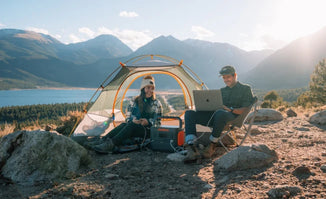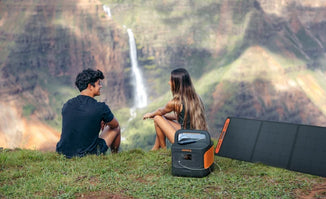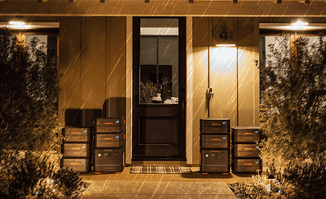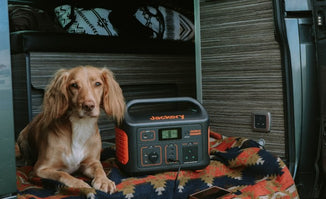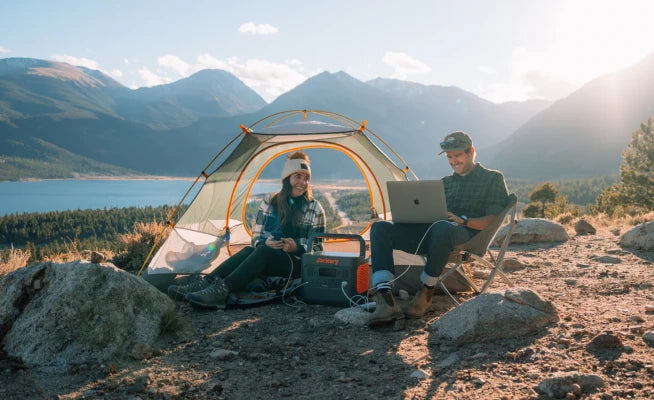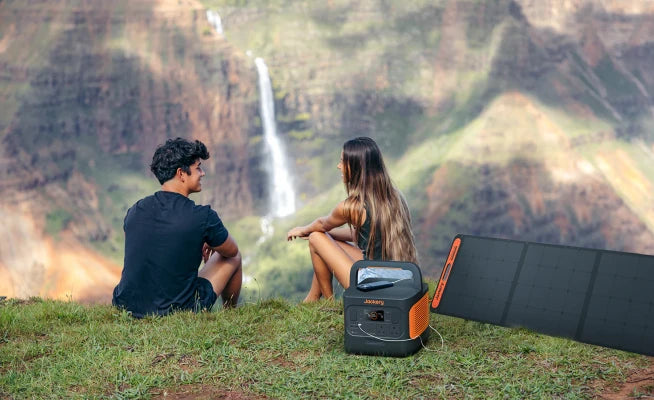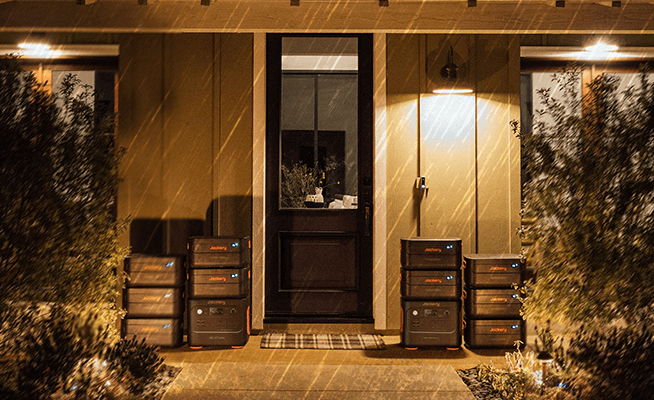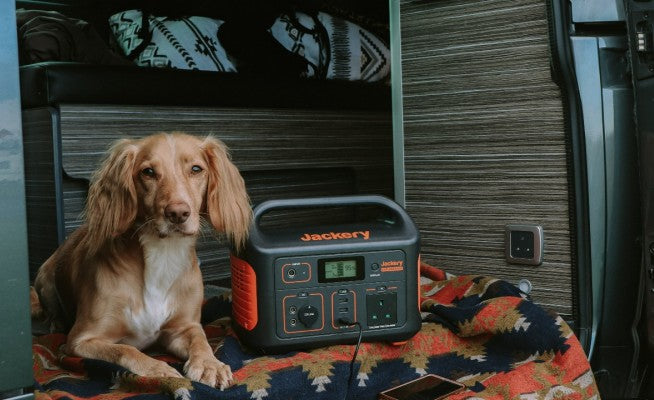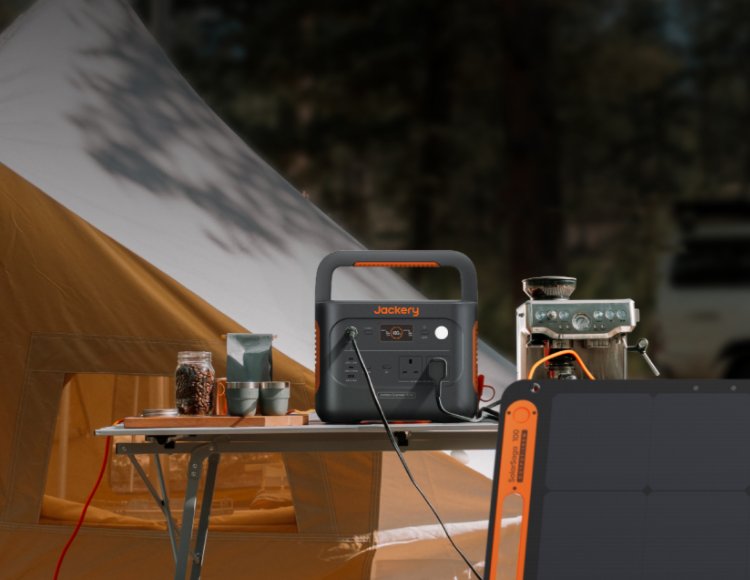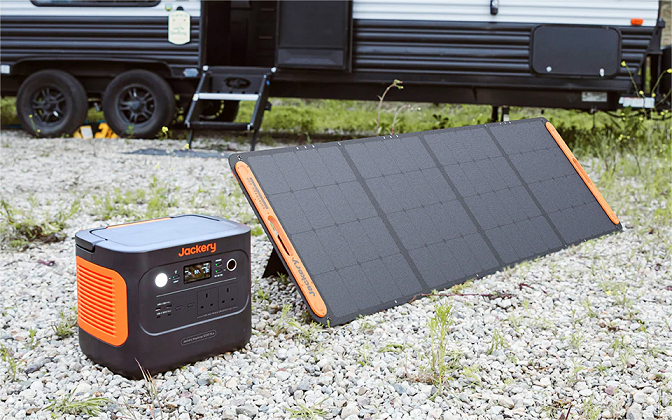The Peak District is situated in central England and is renowned for its rolling hills, plateaus, and valleys. For outdoor enthusiasts, wild camping is an excellent opportunity to explore the beautiful Peak District National Park. Despite legal restrictions, wild camping in the Peak District is still popular, thanks to the culture of mutual respect between wild campers and landowners. Even when wild camping is allowed, wild campers will leave no trace.
Whether you are a wild camping novice or experienced, it is recommended that you read this blog before setting off to learn more about wild camping in the Peak District. Although wild camping is about living in the wild without modern conveniences, a portable power source, like the Jackery Portable Power Station, can power your essential electronics and devices in case of an emergency.
|
Key Takeaways: |
|
l The Peak District boasts unique limestone canyons and tranquil forests, catering to campers with diverse preferences. If you have permission from the landowner, it is legal to wild camp in the Peak District. l Some popular camping areas in the Peak District include Burbage Valley, Kinder Scout, Lawrencefield Quarry, Bamford Edge, Reynards Cave and Bleaklow Moor. l Safety and etiquette tips for camping in the Peak District include not lighting fires, informing others of your whereabouts, leaving no traces, and departing promptly when asked to do so. l Where camping is not allowed, you can also experience traditional camping sites, certified camping farms, eco-lodges or caravan parks. l We highly recommend the Jackery Explorer 100 Plus portable power station to power your phones, GPS devices, lights, and more. |
Why Choose Wild Camp in the Peak District?
As the first national park in the UK, the Peak District is an ideal destination for wild camping enthusiasts, offering magnificent natural scenery, a wealth of outdoor activities, and a profound historical and cultural heritage. There are several main reasons why people choose to wild camp in the Peak District:
Beautiful Natural Scenery
The Peak District spans Derbyshire and Yorkshire, featuring unique limestone canyons, open moorlands, and tranquil forests, catering to a range of wild campers with diverse preferences. For nature lovers, there are numerous caves to explore, including Peak Cavern, Elden Hole, Blue John, and Speedwell.
Rich Outdoor Activities
The Peak District is a hiking mecca in the UK, ranging from the Mam Tor circular trail, suitable for beginners, to the 74-kilometre Limestone Way, which caters to the needs of all kinds of people. In addition, you can also experience mountain bike trails near Mansfield. Boating or fishing in reservoirs, such as Ladybower Reservoir, is also a great way to enjoy the outdoors.
Rich in History and Culture
If you are a history buff, you can find an opportunity to visit Chatsworth House, Lyme Park, Haddon House, Tissington House, the National Tramway Museum or the Mining Museum in Matlock Bath during your wild camp in the Peak District.
Can You Wild Camp in the Peak District?
As a paradise for outdoor enthusiasts, legal camping is possible in the Peak District. Although wild camping in the Peak District is not entirely prohibited, it must be strictly adhered to by legal regulations. The following will discuss whether you can wild camp in the Peak District:
Can You Wild Camp in the Peak District?
Strictly speaking, there is no formal law allowing wild camping in the Peak District. If you have permission from the landowner, then wild camping in the Peak District is legal. Unlike Scotland, most of the land in the Peak District is privately owned or managed by the National Trust or local authorities. It is illegal to stay overnight in the Peak District wild camp without first obtaining permission from the landowner. Therefore, setting up a tent or camping without consent in the Peak District may be considered trespassing. The final result is usually being ordered to leave or confiscation of wild camping equipment. If you refuse to go, you may face prosecution, fines or even imprisonment.
In the Peak District, most landowners will warmly welcome wild campers to camp. However, some landowners in the Peak District are averse to wild camping, primarily due to the lack of parking spaces and irresponsible wild campers causing accidents or littering.
What Are the Consequences of Wild Camping in the Peak District?
When wild camping in the Peak District, if you do not follow the relevant regulations, the following consequences may occur:
Risk of Violation
Most of the land in the Peak District is privately owned or protected by national park regulations. Camping without permission may constitute trespass, which may result in expulsion, fines or even imprisonment in severe cases.
In addition, wild camping is strictly prohibited in some protected areas of the Peak District (such as sites of special scientific interest), and violators may be prosecuted. The risk of wild fires in the Peak District is exceptionally high, so open fires or barbecues are prohibited in many areas, and violators may face legal penalties.
Environmental Damage
Random wild camping in the Peak District often damages vegetation, disrupts soil structure, and affects the habitats of endangered species. Leftover food, plastics, and other materials will harm wildlife and are difficult to decompose. Using soap or excreting faeces near streams may pollute water sources.
Safety Risks
There are also certain safety risks when wild camping in the Peak District. For example, the weather in the Peak District is changeable, and sudden strong winds, heavy rains or low temperatures may cause hypothermia, slips and falls. Its terrain is complex, and the signal coverage is poor; it is easy to get lost without proper preparation.
Where Can I Wild Camp in the Peak District?
The Peak District is a famous outdoor activity destination in the UK, offering many places suitable for wild camping. The following is information about several popular wild camping areas in the Peak District:
Burbage Valley
The Burbage Valley, situated on the eastern side of the Peak District, is renowned for its limestone valleys and karst landforms, which are ideal for trekking and geological exploration. This is an unofficial wild camping area, and the valley is predominantly a natural wilderness. Please o

bey the "Leave No Trace" policy. The National Trust may own some locations, so it's best to check ahead of time to see if wild camping is permitted.
Kinder Scout
Kinder Scout is one of the highest peaks in the Peak District and the starting point for the famous Pennine Way hiking path. The view from the summit of the mountain is expansive and ideal for viewing the sunrise.
It is advisable to find a location at a lower altitude than Kinder Scout for wild camping, such as Woolpacks to the south, which has many boulders that can endure high winds. Wild camping here must also adhere to the laws, which include no camping on mountaintops, short stays between dusk and dawn, staying away from the trail, and no campfires.
Lawrencefield Quarry
This quarry has dangerous terrain, including steep rock faces and rubble areas, and is not recommended for wild camping. However, the surrounding forests and lakes offer numerous potential sites for pitching tents. The unique geological landscape of this abandoned quarry is also suitable for photography and exploration.
Additionally, it is only a few minutes away from the road, making it very convenient for transportation. Please note that this is an informal camping site, and we kindly request that you camp quietly. Some areas may be private property.
Bamford Edge
Bamford Edge is a renowned rock climbing destination, boasting stunning cliffs and offering a picturesque vantage point overlooking the valley. However, the edge of the cliff is mostly steep and rocky, which makes wild camping risky. Camping near the cliff is officially prohibited. Wild campers typically need to select a secluded site to avoid the increasingly crowded areas, as the location has become increasingly popular in recent years.
Reynards Cave
Reynard's Cave is situated adjacent to Dovedale and features numerous old limestone caves, making it an ideal destination for adventurers. However, wild camping in the Cave is not recommended due to potential safety dangers such as wetness and collapse, as well as protection constraints. On the way from Milldale to Reynards Cave, wild campers will pass Dove Holes (a series of riverside caves) and Ilam Rock (a 25-meter-high limestone rock).
Bleaklow Moor
Bleaklow Moor is a remote wilderness area situated in the northern part of the Peak District. It offers a swampy setting that is ideal for exploration. Although the landscape is severe, there are plenty of flat, open spots to pitch a tent. Bleaklow Moor is subject to the Peak District Open Access Right (Right to Roam), but wild camping may be prohibited in certain sections.
Tips on Safety and Etiquette for Wild Camping in the Peak District
Wild camping in the Peak District is a great way to get close to nature and enjoy the outdoors, but safety and etiquette are key to a smooth journey. Here are some tips on safety and etiquette for wild camping in the Peak District:

Tip 1: Do Not Light a Fire
Open fires (including bonfires and barbecues) are prohibited in most areas of the Peak District to prevent wildfires. Even if you use a portable camping stove to cook, make sure to stay away from dry vegetation and keep it under control at all times.
Tip 2: Inform Others of Your Itinerary
Before you set off, be sure to inform your relatives, friends or relevant management of the location, route and expected return time of the wild camp. If you are involved in an accident, you can receive prompt assistance. If your plans change, update the information promptly so that others can assist you in dealing with emergencies.
Tip 3: Prevent Getting Lost
Mobile GPS may not have a signal, so please download offline maps in advance and carry paper maps and compasses. Additionally, follow a clear path and avoid travelling at night. If you get lost, stay calm and contact the rescue service (999 or 112) immediately.
Wales's diverse terrain, including unpredictable weather and mountainous paths, makes reliable navigation crucial. Your smartphone, a dedicated GPS device, or a headlamp are lifelines. A Jackery Portable Power Station ensures these devices remain charged. For instance, a Jackery Explorer 100 Plus (99.2Wh, 2.1 lbs) can recharge an iPhone 15 multiple times (6-7 times) or keep your GPS device going for days, providing essential peace of mind in remote areas.
Even in remote Welsh valleys, there might be spots with intermittent mobile signals. A charged phone means you can seize these opportunities to call for help in an emergency (e.g., Mountain Rescue) or update your contact person on your progress.
Tip 4: Be Familiar with First Aid Measures
Before departure, learn basic first aid skills, including how to handle sprains, stop bleeding, apply bandages, and perform cardiopulmonary resuscitation. Carry a basic first aid kit containing disinfectant, plasters, painkillers, and other essential items.
Tip 5: Leave No Trace
When wild camping in the Peak District, it is best to follow the principle of "no trace camping" and keep the campsite in its original state. The most important thing is to remove all garbage, including food scraps, paper towels, and other similar items. Avoid destroying vegetation and refrain from moving rocks or cutting down trees. Keep excrement away from water sources and bury it in a pit at least 20 cm deep.
Tip 6: Arrive Late, Leave Early, and Control Noise
Activities conducted in the early morning or at dusk can minimise interference with landowners and wildlife. Therefore, you should arrive at the wild camp site as late as possible and leave as early as possible. Additionally, you should remain quiet during your wild camping in the Peak District and refrain from playing music or engaging in loud conversations.
Tip 7: Act As Soon As Possible When Asked to Leave
Wild camping anywhere in the Peak District requires prior consent. If you are asked to leave by a ranger or landowner, cooperate immediately and communicate politely.
What to Consider When Wild Camping in the Peak District?
It is essential to be well-prepared for a wild camp in an environment with high altitude, complex terrain, and a changeable climate. Here are the key considerations for a wild camp in the Peak District:

Wild Camp Size
A large wild camp or too many people will usually cause severe damage to the ecological environment of the wild campsite. Therefore, please control the size of the wild camp team to three people or less. Tents and other wild camp equipment should also be lightweight and reusable.
Water Source Management
Wild camps usually require bringing enough drinking water, and it is recommended to use 2-3 litres per person per day. If necessary, use water purification equipment (such as a water filter or water purification tablets) or boil the water for disinfection. It is strictly forbidden to drink untreated water or pick unknown plants. Wash water should be kept away from the water source to avoid contamination.
Power Supply
Wild camps often need to find ways to address the issue of power supply. It is best to prepare a large-capacity portable power station, such as the Jackery Explorer 100 Plus, to charge electronic devices. If conditions permit, bring a solar charging panel to replenish the power of the portable power station at any time.
Rain Prevention Measures
The weather in the Peak District is changeable, so check the real-time forecast of the Met Office before departure. Suppose you decide to go wild camping in the Peak District during the rainy period, in addition to a professional rainproof tent. In that case, it is best to bring a waterproof, coated jacket, a raincoat, and spare plastic sheeting. The tent site should also avoid flood channels and low-lying areas, instead choosing slightly higher and well-drained ground.
Warmth Strategy
Even the upcoming summer will become cold due to rain, so please take warm measures. A sleeping bag suitable for the season, with a temperature scale at least 5℃ lower than the expected nighttime temperature. A moisture-proof mat with an R-value of≥2.0 will effectively insulate the ground from cold. Bringing a warm jacket will help to resist the cold in the early morning and evening in the Peak District.

Jackery Portable Power Station for Wild Camping
Wild camping in the Peak District offers an incredible opportunity to immerse yourself in stunning natural landscapes, from the rugged mountains of Snowdonia to the remote coastal paths. While wild camping generally requires permission from landowners in Wales, when done responsibly and discreetly, a Jackery Portable Power Station (PPS) can significantly enhance your experience, making it safer, more comfortable, and more sustainable.
Traditional generators are noisy and produce harmful fumes, completely undermining the tranquillity and clean air of the Welsh wilderness. A Jackery operates silently (typically under 30dB) and produces zero emissions.
Jackery Portable Power Stations are designed to be paired with Jackery Solar Panels. While the Peak District experiences its fair share of cloudy days, even intermittent sunshine can effectively top up your power station. This means you can extend your time off-grid significantly, reducing the need to visit towns solely for charging devices. This is particularly beneficial for longer multi-day traverses.
Jackery Explorer 100 Plus
Wild camping in the Peak District, like much of the UK, requires adherence to strict "leave no trace" principles and often landowner permission. Assuming you're either in a tolerant area or have permission, the Jackery Explorer 100 Plus is an exceptionally well-suited power solution for this type of adventure.

Ultra-Lightweight & Compact: The Gold Standard for Wild Camping. At just 2.1 lbs (965 grams), the Explorer 100 Plus is designed specifically for weight-conscious activities, such as backpacking and wild camping. In the Peak District, where you'll be traversing diverse terrain, including steep climbs and moorland, every gram counts. This weight adds negligible burden while providing substantial power.
Essential Power for Navigation & Safety: The Peak District's weather can change rapidly, and visibility can drop quickly, especially on the high moors. Your smartphone (with mapping apps like OS Maps or Komoot) or a dedicated GPS device is critical. The 100 Plus can provide multiple full charges for your phone (e.g., 6-7 charges for an iPhone 15), ensuring your navigation tools don't fail when you need them most.
Optimised for Modern Electronics: Modern smartphones, tablets, and even lightweight laptops (like a MacBook Air) increasingly use USB-C for fast charging. The 100 Plus's 100W USB-C output allows you to charge these devices, minimising downtime during your trip rapidly. With two USB-C and one USB-A port, you can charge multiple devices simultaneously (e.g., phone, headlamp, camera), which is incredibly convenient at the end of a long day.
Solar Charging Capability: The Peak District, especially in summer, offers good daylight hours. Pairing the 100 Plus with a small, lightweight solar panel (like the Jackery SolarSaga 100W) allows you to passively recharge the unit during sunny periods while hiking or at camp. This extends your power autonomy far beyond the initial charge, reducing reliance on public charging points.
Built for Outdoor Reliability: The long-lasting LiFePO4 battery chemistry ensures the unit maintains its performance over many camping trips, offering durability (with over 2000 cycles to 80% capacity) critical for consistent outdoor use.
|
Jackery Explorer 100 Plus Running Time |
|
|
GPS Device (30W) |
2.6H |
|
Phone (20W) |
6.2 Charges |
|
Flashlight (5W) |
15.8H |
|
Camera (8.4W) |
9.9H |
|
Drone (90W) |
0.9H |
(*The working hours are only for reference; the actual working hours depend on your usage.)
Alternatives to Wild Camping in the Peak District
If you cannot legally camp in the Peak District, you can seek alternatives. Here are several options for wild camping that are suitable for different needs, retaining the natural experience while providing more comfort or amenities:
Traditional Campsites
Traditional campsites are typically found in picturesque natural settings such as mountains, lakes, or forest margins. This type of campsite offers tent-pitching areas, basic living amenities (including water, power, toilets, and showers), and recreational facilities such as sports grounds and campfire areas. It is better suited for outdoor lovers seeking low-cost, high-freedom camping, as well as families new to camping.
Recommendations for traditional campsites in the Peak District:
Certified Camping Farms
As the name implies, certified camping farms combine agricultural ecology and camping. Farmers often maintain them and are formally certified to assure environmental protection and service quality. They are usually located in the countryside or on farms, offering camping as well as the opportunity to pick and interact with animals, among other activities. It is better suited to parent-child households, educational groups, or urbanites seeking a slower country lifestyle.
Recommended certified camping farms in the Peak District:
Eco-Cabin
Eco-cabins are designed with environmental preservation in mind, focusing on low-carbon lodging and incorporating features such as solar energy and composting toilets. Some eco-cabins may also include rooftop stargazing windows and outdoor hot spring pools. It is more suited for environmentalists, travellers, and couples seeking a one-of-a-kind accommodation experience.
Recommendations for eco-cabins in the Peak District:
Caravan Park
Caravan parks are intended explicitly for RV travellers, offering one-stop parking and services, as well as the flexibility to camp and travel. Caravan parks often include water and electricity, as well as sewage treatment, and are ideal for short-term stays. It is better suited to self-driving enthusiasts, long-distance travellers, or parties looking to try something different while camping.
Recommended caravan parks in the Peak District:
FAQs
The following are the frequently asked questions about wild camping in the Peak District.
1. Where in the Peak District can you wild camp?
Because the land in the Peak District is privately owned or managed, wild camping is generally not allowed. If you want to wild camp in the Peak District, you need to get permission from the landowner in advance. If you are found camping without permission, you may be asked to leave and not leave any trace.
2. Do you have to pay to camp in the Peak District?
It depends on the situation. Most of the land in the Peak District is privately owned or managed by various organisations and requires permission. Most landowners will be happy to camp for free, but a few will charge a fee. If you choose to camp at a campsite, farm or caravan park in or near the Peak District, you will usually have to pay a fee.
3. Where is it legal to wild camp in the UK?
In the UK, only Scotland allows wild camping. In England, Wales or Northern Ireland, it is illegal to wild camp without the landowner's permission. However, in parts of Dartmoor National Park in England, wild camping is allowed.
4. What is the first rule of wild camping in the Peak District?
The first rule of wild camping in the Peak District is to leave no trace. Therefore, you must ensure that there is no trace of your presence during wild camping in the Peak District or before you go. Thus, if you encounter any rubbish, please collect it and dispose of it at the designated point.
Final Thoughts
Whether you want to get away from the daily grind, enjoy the scenery of the Peak District, or want to sleep under the stars, this guide covers everything you need to know before embarking on a wild camping trip in the Peak District. However, wild camping in the Peak District must adhere strictly to regulations. Otherwise, you may face legal prosecution, increased environmental pressure or personal danger. In addition, a successful wild camp in the Peak District should also consider scale, water sources, electricity, rain protection and warmth.






































